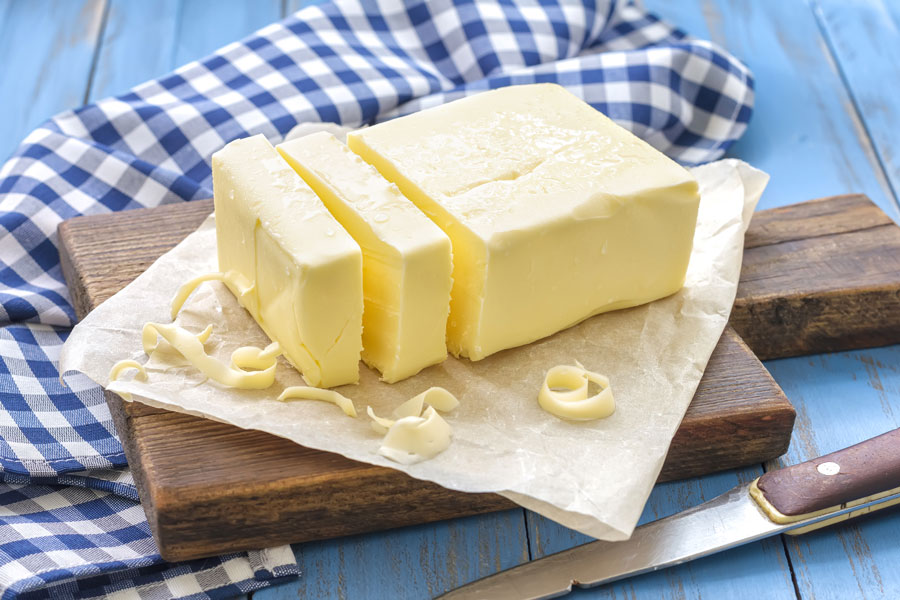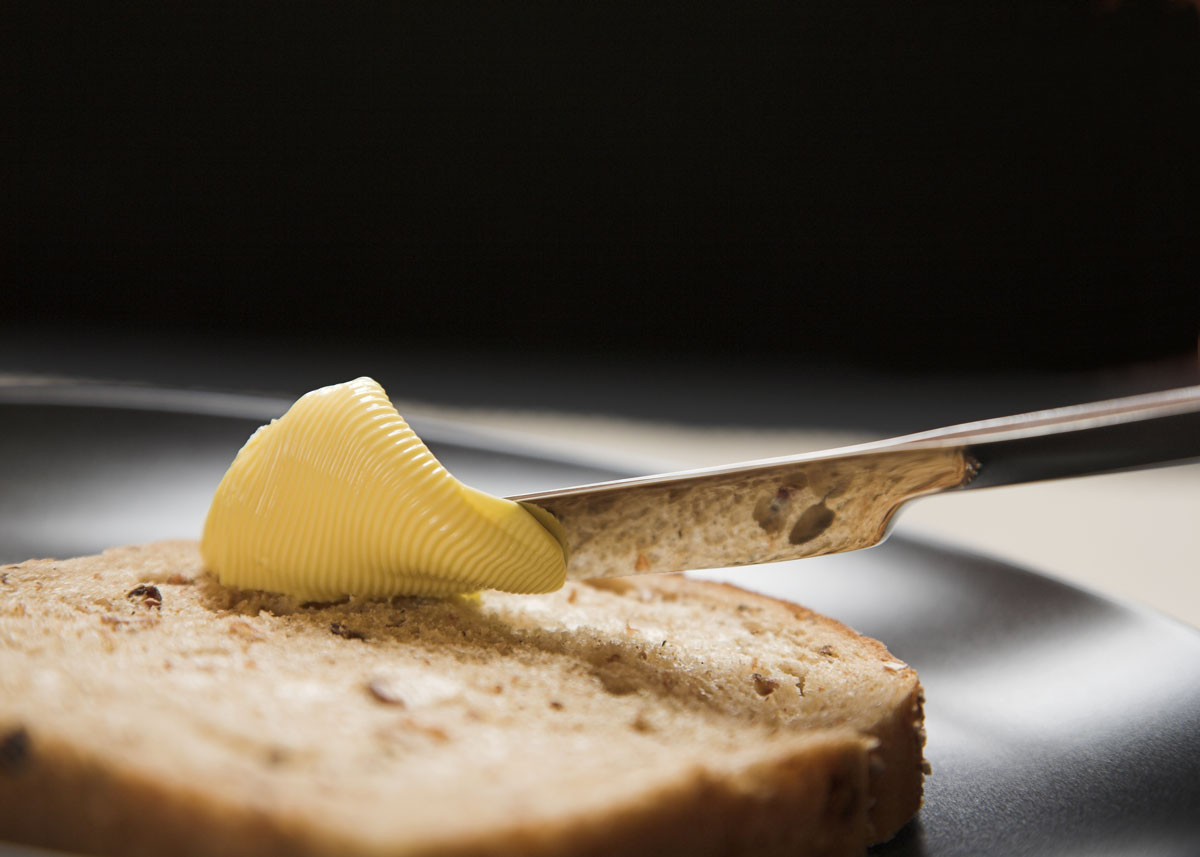
Butter basics: What is butter, how it’s made and more
12th February 20 - 8 minute read
- Butter
- Discover the basics of butter – what it is and all-important ingredients
- Find amazing butter facts – including where that yellow colour comes from
- Explore the differences between types of butter
- What is spreadable and how is it made?
- Learn from the experts on all things butter
It’s a beloved part of breakfast, a luscious layer to your sarnie, and a darn good topping to your snack.
Oh yes – when it comes to taste, there aren’t many things better than a bit of butter.
But what exactly, we hear you ask, is butter? How is it made and why oh why is it so yellow?
Never fear. You’ve come to the right place to learn everything you could possibly want to know – along with plenty of butter facts. Tuck in and enjoy.
Our experts
Zachary Glover: Food scientist and crumpet enthusiast.
Lise Larson: Arla nutritionist.
Marianne Hansen: Butter Product Developer.
What is butter?
A staple dairy product of Britain’s homes, the ingredients in butter are simple – as it is made by churning milk or cream, which is cooled until it forms a solid block.
Where does butter come from?
Nobody knows for sure where or when butter was first created. It features in The Bible, was around in Ancient Rome, and has been enjoyed by hungry humans for thousands of years.
What is butter made of?
Usually butter is made from cow’s milk, though goats, sheep and even yaks and buffaloes are used in some parts of the world.
However, not all milk-producing animals can join the butter party – which is why you’ll never get butter made from a camel.
That’s because their milk is lower in fat, which makes it much harder to churn, and you’ll only get very small quantities for your efforts.¹
What are the ingredients of butter?

Butter is a masterpiece of simplicity, and a celebration of classic, traditional dairy. In its purest state, butter is just cream from milk that has been churned.
On the supermarket shelves, you’ll often find a sprinkle of salt has been added to the butter for an extra zap of flavour – as is the case with Anchor Original.
The one crucial rule? “It has to be above 80% dairy fat to be legally-called butter,” says food scientist Zak.
You can check out EU Reg. 1308/2013 for all the legal ins and outs of what makes butter, butter.
Why is butter yellow?²
When cows are grazing on grass, they take in a naturally occurring vitamin called beta-carotene. This helps to give milk its yellow, buttery hue.
“It’s the same thing that gives carrots their colour,” explains Zak.
In milk, beta-carotene mostly keeps the colour to itself. You might notice a slightly yellow hue in whole milk from grass-crunching cows, compared to others.
But it’s when you start churning that things really start happening.
“The reason that butter ends up yellow is because you’re concentrating all the fat that’s present in the cream,” Zak notes.
Why is British butter so yellow?
Yellow butter is produced by grass-crunching cows, because they’re taking in lots of beta-carotene from the great outdoors.
Lush, green British fields are ideal, because there’s so much for the cows to tuck into – so butter from the UK is often a particularly rich yellowy colour.
Salted butter vs unsalted butter

We’re tackling the big butter issues: right here, right now. Which do you prefer?
Does unsalted butter taste different from salted butter?
Unsalted butter – such as Anchor Unsalted – is usually creamier, while salted butter tends to be slightly more flavoursome.
But salt levels vary from brand to brand, so it all depends on the butter you’re using.
What is the difference between unsalted butter and salted butter?
Salted tends to have more flavour. But it hasn’t always been the stand-out difference. Back in the day, people used salt to preserve their butter.³
These days, we’ve got fridges that keep our butter cool and make sure its lasts for longer.
But salted butter is still a popular option. Probably because it’s become something of flavoursome food hack.
When should you use unsalted and salted butter?
Some people say salted butter is ideal for savoury food and unsalted butter is best for baking. It’s even been debated on Radio 4.
But honestly, there are no hard and fast rules. Butter is all about delicious taste and feeling good, so use whichever you fancy.
Spreadable
Saving us all from the heartbreak of having to wait for butter to soften, spreadable has become a household essential for many families.
Is spreadable the same as butter?
Spreadable can be created in lots of different ways. Today, it’s often made by blending traditional churned dairy butter with vegetable oils.
In Anchor Spreadable, for example, rapeseed oil is added to Original Block Butter. That’s the secret to its spreadable texture.
Is spreadable real butter?
Traditional butter is made by churning milk or cream, sometimes adding salt. Spreadable uses oil and may have less saturated fat.
That said, the main ingredient in Anchor Spreadable is butter, which is why it still has that quintessential buttery taste.
What does the future of butter look like?
Over to Zak, our butter guru.
“People are looking more and more into how you can deliver butter that has the same tastes and textures, the same melting behaviours that you're familiar with and enjoy – but trying to reduce the calorie content a little bit,” he explains.
“But I think good old standard butter is still going to have a place in the future as well.”
Butter benefits
What is the value of butter? Is butter healthy?
According to nutritionist Lise, the real value of butter is found in its taste – and the way in which this can actually help to create a balanced diet.
“It provides taste and it provides kind of a unique taste,” she explains.
“You can't get [it] from anywhere else. Butter is so nuanced and rich.
“Healthy diets are tasty diets and it's easy to make things that are normally a little boring palatable by adding a little butter.
“Knowledge about our foods and cooking from scratch is more important for a healthy diet than many believe. We need real, whole foods, a variety of natural ingredients, which we can’t get if we rely too much on highly-processed foods.
“Butter is a solution for adding flavour to such whole food-based diets, and [using] a little flavour is a very good thing.”
Butter the food, butter the mood
When you take a bite of something buttery, your taste buds sound a collective ‘ahhh’. Your shoulders relax, you feel warm inside and your brain fizzes with happiness.
It can turn a frown upside down or make your smile even bigger.
“You can't beat a bit of butter on some warm fresh bread,” says Zak.
“There’s something quite hearty about it, seeing how much you can fit into all the holes in the crumpets. I think there’s a sort of enjoyment in the sensory [nature] of it.”
To find out more about Anchor’s approach to butter-making – and our passion for buttering people’s moods – learn about our story, our products and everything we do.
FUN FACTS
Butyrophil
noun
- Someone with a soft spot for butter
Mound of Butter⁴
French artist Antoine Vollon made butter the star of the show in his famous oil painting, now on display at the National Gallery of Art in Washington D.C.
The Butter Cow⁵
In the US state of Iowa, sculptures made of butter have become an engrained part of the annual State Fair. Since the first butter cow was carved in 1911, the creative mission has been taken on by five butter sculptors – with the talented Sarah Pratt currently at the helm.
Butter The Movie⁶
In 2011, a film called ‘Butter’ came to cinemas, telling the tale of competitive butter sculpting (what else) and starring Jennifer Garner.
Fastest time to butter ten slices of bread
In 2018, Simarjit Chhabra buttered up ten slices in just 20.8 seconds in Los Angeles⁷.
Largest butter sculpture
New York artist Sharon BuMann made a butter sculpture of the Texas icon ‘Big Tex’, which weighed in at more than 4,000lbs – that’s almost 300 stone⁸.
¹ https://www.livescience.com/53579-camel-milk.html
² https://well.blogs.nytimes.com/2016/10/14/since-milk-is-white-why-is-butter-yellow/
³ https://www.bbc.co.uk/sounds/play/p056zylr
⁴ https://www.nga.gov/collection/art-object-page.75030.html
⁵ https://www.iowastatefair.org/about/butter-cow/
⁶ https://www.imdb.com/title/tt1349451/
⁷ https://www.guinnessworldrecords.com/world-records/91873-fastest-time-to-butter-10-slices-of-bread/
⁸ https://www.guinnessworldrecords.com/world-records/81495-largest-butter-sculpture/
- Butter